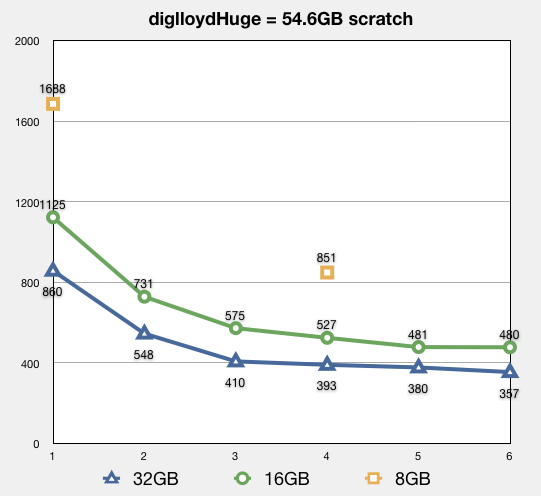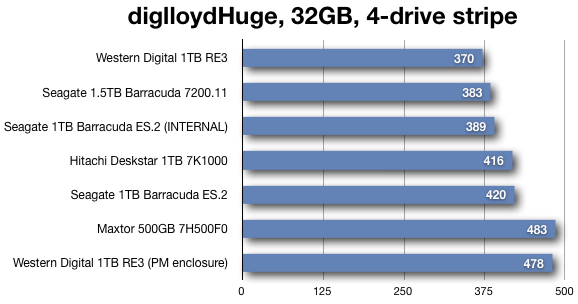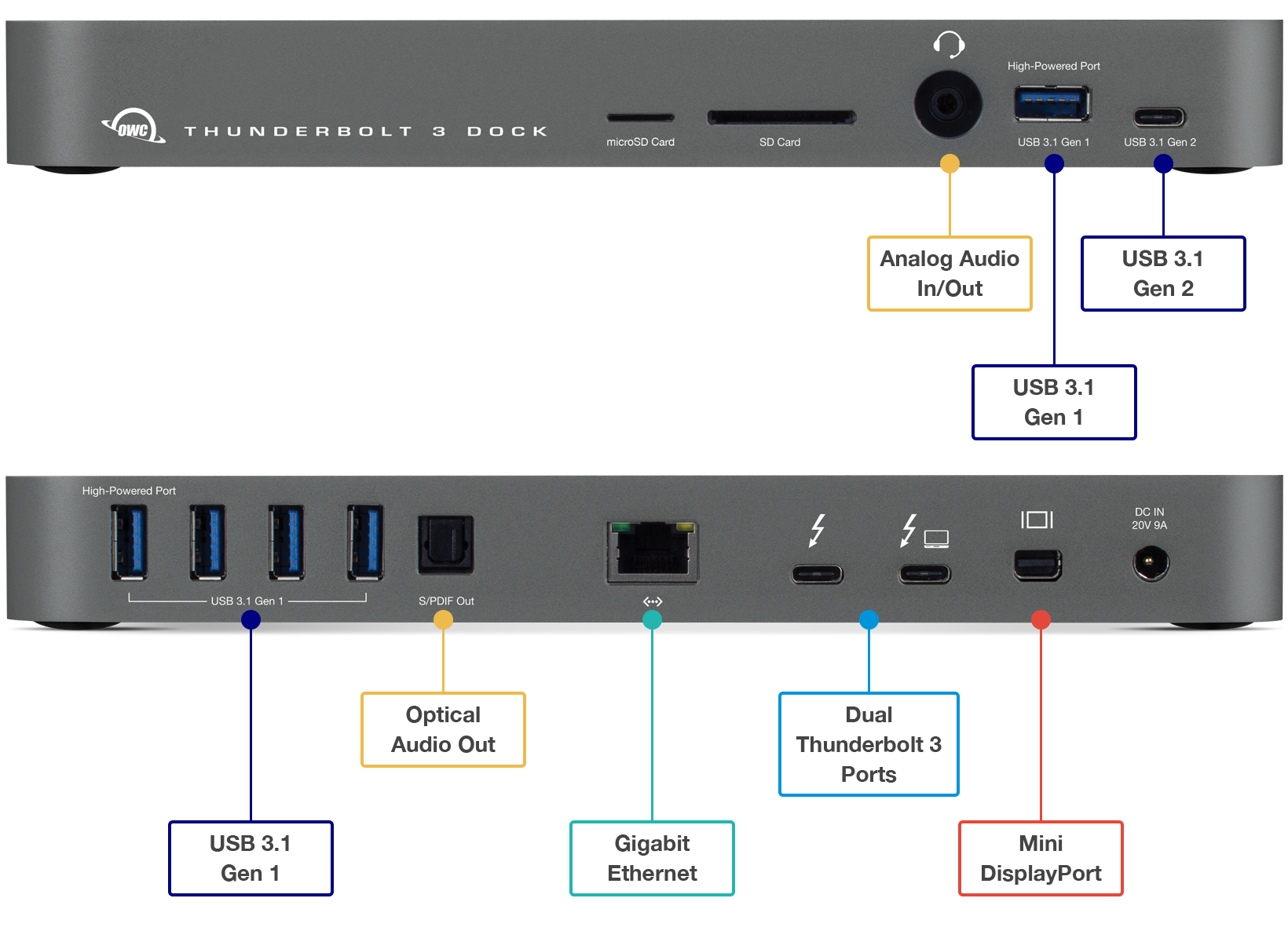
$220 SAVE $130 = 37.0% Western Digital 16.0TB Western Digital Ultrastar DC HC550 3.5-in… in Storage: Hard Drives
|

$500 SAVE $75 = 13.0% OWC 1.0TB OWC Atlas Pro SDXC V60 UHS-II Memory Card (2-Pack) in All Other Categories
|

|

|

|

|

|

|

|

|

|
Test results for Photoshop CS4 on Mac Pro
Related: Apple macOS, caching, CPU cores, Expose Somewhat To Right, Expose To The Right, hard drive, Mac Pro, memory, optimization, Other World Computing, Photoshop, RAID, Seagate, software, SSD
Two benchmarks were used differing only in image size: diglloydMedium (20,000 pixel-wide image, 15.7GB scratch file) and diglloydHuge (40,000 pixel-wide image, 56.4GB scratch file). The scratch file sizes are the size after the benchmark test is run. See the Benchmark Actions page for more on the test benchmarks.
Tests were run using 1/2/3/4/5/6 drives for scratch with the 2/3/4/5/6 drives setup using a striped RAID volume, each drive contributing 32GB from the fast side of the drive. Memory configuration was varied at 8/16/32GB.
For the diglloydMedium test (15.7GB scratch file at the end of the test), the 16GB configuration was actually slightly faster than 32GB. This is almost certainly due to the Photoshop 32GB bug which limits its memory use to 2810MB instead of 3072MB. The time difference does not exceed 4%.
The drives used for the main test matrix were the Seagate Barracuda ES.2 ST31000340NS. For a comparison with other brands and models of hard drives, see Drive Comparison below.
Mac Pro configuration
For most of the tests here, system configuration (Mac Pro) was as follows:
Mac Pro quad-core 3.0GHz, Mac OS X 10.5.5
Extra plugins: BiggerTiles, DisableScratchCompress
Other setup: histogram panel hidden
RAID stripe size: 32K
32GB memory: photoshop mem=2810/100%, history=20, cache-levels=3
16GB memory: photoshop mem=3072/100%, history=20, cache-levels=3
8GB memory: photoshop mem=3072/100%, history=20, cache-levels=3
Drives: SEAGATE Barracuda ES.2 ST31000340NS (for main test matrix, then as specified)
See also results for the 2008 octa-core Mac Pro and 2009 Mac Pro Nehalem.
Results for diglloyd Medium PERMALINK
This is the medium-sized test. See diglloydHuge results further below. For this test:
- 8GB memory is 45 - 70% slower than 16GB memory.
- A single drive is 60 - 220% slower than a striped RAID.
- 8GB with single drive is 320% slower than the optimal configuration.
Adding 32GB memory did not improve performance, because 16GB was adequate to cache the data written to the scratch disk by Photoshop. Determining the scratch size requirements is essential to knowing how much memory is needed.
Note that a RAM disk is slightly slower than a 4-drive stripe.

(8GB measurements checked only with 1, 4 drives)
Results for diglloyd Huge PERMALINK
For this larger test (approximately 4 times the size of diglloydMedium):
- 8GB memory is 50 - 60% slower than 16GB memory.
- 8GB memory is 96 - 216% slower than 32GB memory.
- 16GB memory is 30 - 40% slower than 32GB memory.
- A single drive is 60 - 120% slower than a striped RAID.
- 8GB with a single drive is 372% slower than the optimal configuration.
Best compromise: 32GB with a 3 or 4-drive striped RAID (10-15% slower than best possible)
Best performance: 32GB with a 6-drive striped RAID
For diglloydHuge, adding 32GB memory improved performance substantially, because 16GB was inadequate to cache the scratch data (about 56GB). Determining the scratch size requirements are essential to knowing how much memory is needed. Unfortunately, 32GB is the memory limit for the Mac pro. Presumably, if 64GB could be installed, then times would drop further.
Using 16GB instead of 32GB causes 25-40% longer running time, depending on drives.
Lesson: determine how much memory you need and install more if needed for a big time savings.

(8GB measurements checked only with 1, 4 drives)
Data as measured. Results were cross-checked in various ways.
| # of Disks (SEAGATE Barracuda ES.2 ST31000340NS) | |||||||
|---|---|---|---|---|---|---|---|
| Memory | Test | 1 | 2 | 3 | 4 | 5 | 6 |
| 8GB | diglloydMedium | 220 | - | - | 124 | - | - |
| 16GB | diglloydMedium | 150 | 90.5 | 74 | 72 | 67.5 | 68.5 |
| 32GB | diglloydMedium | 152 | 94 | 74 | 71 | 70 | 70 |
| 8GB | diglloydHuge | 1688 | - | - | 851 | - | - |
| 16GB | diglloydHuge | 1125 | 731 | 575 | 527 | 481 | 480 |
| 32GB | diglloydHuge | 860 | 548 | 410 | 393 | 380 | 357 |
diglloydHuge with eight-core Mac Pro — hard drives and SSD PERMALINK
February 14, 2009
These results are with 32GB memory on a 2.8GHz eight-core Mac Pro with Mac OS X 10.5.6. The 8-core Mac Pro is about 10% faster overall than the 3.0GHz quad-core Mac Pro. See also the review of the Intel X25-M and review of the Intel X25-E. and my new winner, the OWC Mercury Elite SSD.
Results with the Intel X25-M solid state drive show that nothing substitutes for fast write speed. The Intel X25-M is limited to about 75MB/sec write speed (250MB/sec read!). During the Photoshop test run of diglloydHuge, write speed of 250-300MB/sec was observed with the 4-drive stripe of hard drives, but with the 2-drive stripe of the Intel X25-M, write speed was maxed-out at 148MB/sec, their maximum speed.
Extrapolating the results, a 4-drive stripe of the Intel X25-M should provide speeds comparable to those with hard drives, but of course at far higher cost View SSD pricing. Alternately, two of the enterprise-grade X25-E drives (170MB/sec for writes) should provide similar performance. Bottom line: hard drives are clear winners for write speed until SSD write speeds can be improved.
| Brand / model | Times (sec) | Avg. (sec) | Comments |
|---|---|---|---|
| Western Digital 1TB RE3 WD1002FBYS-01A6B0 |
305, 308 | 307 | Internal Mac Pro drive bays. Four-drive stripe. |
| Intel X25-M 80GB X 2 | 516, 521 | 518 | Internal Mac Pro SATA ports (the two extra ports on the motherboard). Two-drive stripe. Results are similar to those with 2-drive stripes with hard drives. |
| Intel X25-M 80GB | 879 | 879 | Single drive. |
Ideal for any Mac with Thunderbolt 3
Dual Thunderbolt 3 ports
USB 3 • USB-C
Gigabit Ethernet
5K and 4K display support plus Mini Display Port
Analog sound in/out and Optical sound out
Works on any Mac with Thunderbolt 3
Update for Photoshop CS4 11.0.1 (Feb 27, 200) PERMALINK
The diglloydHuge benchmark was run before and after installing the 11.0.1 update on an 8-core 2.8GHz Mac Pro with 32GB memory and a 4-drive stripe (Western Digital RE3), Mac OS X 10.5.6.
The before/after results show that performance remains the same:
Before: 5:05, 5:08
After: 5:10, 5:07
The memory allocation issue has not been resolved, hopefully that will come in sometime soon.
diglloydHuge with Mac Pro Nehalem 2.93 GHz PERMALINK
March 28, 2009
These results are with a 2.93GHz Mac Pro Nehalem with a 4-drive striped (Western Digital RE-3).
This is our new speed champ, and even though the test is still heavily dependent on disk speed, the 2.93GHz Mac Pro Nehalem (see review) still comes out the winner by about 6%.
| Brand / model disk | Times (sec) | Avg. (sec) | Comments |
|---|---|---|---|
| 32GBv Western Digital 4X1TB striped partition | 294, 287, 287 | 289 | Internal Mac Pro drive bays. Four-drive stripe. |
| 24GB Western Digital 4X1TB striped partition | 293 | 293 | The 24GB configuration is just as fast as the 32GB configuration! This might have something to do with Photoshop’s 32GB memory bug. |
Drive comparison PERMALINK
The extensive test matrix detailed above was not replicated for the other brands of hard drives because the trends are clear, and unlikely to change in terms of memory and number of hard drives for the RAID stripe.
Evaluating brand and model of hard drive
A 4-drive striped RAID (32K stripe size) was compared for each brand/model as shown below, using 32GB memory. Multiple trials were performed;, with all brands and models showing variance between trials with maximum variance of about 6%. Except as noted, the 4 drives were installed in a FirmTek SeriTek/2eEN4 connected with 4 eSATA cables to a Sonnet Tempo E4P PCI-Express card. Both products are recommended, and available at OWC.
Note that the Seagate 1TB Barracuda ES.2 drives tested internally and externally were different units (8 different drives), so strictly speaking that’s another test variable that changed. It does appear that the internal Mac Pro SATA ports run slightly faster than the external setup. The Mac Pro internal bays/ports are simpler, cheaper, and quieter, so use them if they’re available.
The winners PERMALINK
The enterprise-class Western Digital “RE3” is the clear winner. But note the 30% performance penalty when the same drives are used in a “port multiplied” (PM) SATA enclosure—don’t use PM for tasks that require high-performance.

Worth noting is that the Seagate 1TB Barracuda ES.2 performs about 9% faster on the internal Mac Pro ports than in the external enclosure. The same might also be true for the other drives, but this might be drive-dependent. The MacBook Pro results show that the particular combination of drive and hardware can change the relative rankings: the high level point here is that a a 4-drive stripe is the big win, with smaller improvements obtained by choosing the brand/model of drive.
Surprisingly, the consumer-grade Seagate 1.5TB drive was the 2nd-best performer, making it a relative bargain: 50% more storage and nearly the same performance. One warning: some users have reported 20-30 second “freezes” on Mac OS X with file-system journaling enabled. Journaling is not needed for a scratch disk, but is important for data integrity in the event of a system crash; it is enabled by default, but can be quickly enabled or disabled by SoftRAID. Apple’s Disk Utility requires erasing the drive to change the journaling setting.
Observe that the previous generation 500GB Maxtor 7H500F0 drives do not perform nearly as well as any of the current 1TB drives. Even so, they are a close match for the fastest drives crippled by a Port-Multiplied enclosure.
| Brand / model | Times (sec) | Avg. (sec) | Comments |
|---|---|---|---|
| Western Digital 1TB RE3 WD1002FBYS-01A6B0 |
374, 365, 365, 375 | 370 | +0% |
| Seagate 1.5TB Barracuda 7200.11 ST31500341AS |
370, 386, 383, 396 | 383 | +3.5% |
| Seagate 1TB Barracuda ES.2 ST31000340NS |
390, 395, 387, 386 | 389 | +5% Internal Mac Pro bays/ports |
| Hitachi Deskstar 1TB 7K1000 HDS721010KLA330 |
407, 420, 422 | 416 | +12% The (not tested) A7K1000 enterprise class drive might (or might not) be faster |
| Seagate 1TB Barracuda ES.2 ST31000340NS |
408, 419, 435, 419 | 420 | 13.5% |
| Maxtor 500GB 7H500F0 | 483 | 483 | +31% |
| Western Digital 1TB RE3 WD1002FBYS-01A6B0 in port-multiplied enclosure |
478 | 478 | +29% Avoid “port multiplication” (PM) |
CPU utilization PERMALINK
The Activity Monitor graph below shows the CPU utilization during the diglloydHuge benchmark with a 4-drive stripe RAID partition used for the scratch volume. Very poor CPU utilization is the norm with large files because most of the time is spent waiting for disk I/O.
A faster CPU (eg 3.2vs 2.8GHz) is of little help; mentally visualize a 13% reduction in the green+red areas of the graph: total running time might improve by a 3-4% at best! Or it might improve 0%: a well-written program can overlap computation with disk I/O, at least to some degree.
In this example (diglloydHuge), CPU-intensive operations include upscaling the image (spike at left) and converting to Lab mode (spike at 3/4 mark). Rotation takes a modest amount of CPU power (middle), and inverting (right) takes almost none. Nerds can look at the iostat data.
Bottom line: very low average CPU utilization. Performance is governed mainly by available memory and scratch volume speed, not CPU clock rate. Invest in memory and a fast striped RAID for such tasks.

2.3.1 What activity monitor says about 32GB / 16GB / 12GB / 8GB
The screen dumps below are taken from Apple’s Activity Monitor. The memory showing as is the memory being used for caching. Observe how a huge chunk of free memory (green) is gobbled up for caching (blue) as a result of the Photoshop scratch disk activity.
Note that if you start an application, or any kind of background program starts up (eg SpotLight or Time Machine), suddenly this cached memory gets cannibalized for other purposes, resulting in lots of disk activity and sluggish performance: this is one reason why you should have extra memory.
The Mac OS X system will not allow memory to drop to zero; it always keeps a small amount in reserve, around 3-5%. Only with 16GB of system memory is there memory left over after the diglloydMedium test completes; with 12G and 8GB the amount left over is effectively zero for the purposes of caching. With 32GB and diglloydHuge, all available memory is utilized (the resulting scratch file is 56.4GB).


The memory usage below is after running diglloydMedium:







 diglloydTools™
diglloydTools™


